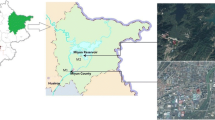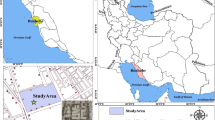Abstract
Monitoring of Beijing PM10 was undertaken, data collected in a period of one year showed seasonal variation of the mass level of Beijing PM10 being highest in winter and spring, lower in summer and lowest in autumn. PIXE was used to investigate the chemical elements in PM10. Results showed the chemical concentration also varied seasonally. Percentage of the masses of the crustal elements such as Al, Si, Mg, K, Ca, Fe, Mn and Ti, reached highest in spring and S, Cl, Pb, As, Cu, Ni and Zn which originated from anthropogenic sources reached highest in winter. The monitoring data showed gradual increase of the abundance of the elements from spring to winter in Beijing air and especially strong correlation of Si, Ca, Al, Fe, Mg and Ti from the factor analysis indicating these elements coming from the earth crust or soil, S, Zn and Pb probably from industrial pollution and Cl and As from combustion.
Similar content being viewed by others
References
Cao, L., Landsberger, S., Basunia, S., & Tao, Y. (2004). Study of PM2.5 in Beijing suburban site by neutron activation analysis and source apportionment. Journal of Radioanalytical and Nuclear Chemistry, 261(1), 87–94.
Chang, H., Yang, S., & Dong, J. (2000). Study of chemical elements in aerosol. Environmental Chemistry, 19(6), 485–499 (in Chinese).
Chapman, R. S., Watkinson, W. P., Dreher, K. L., & Costa, D. L. (1997). Ambient particulate matter and respiratory and cardiovascular illness in adults: Particle-borne transition metals and the heart-lung axis. Environmental Toxicology and Pharmacology, 4, 331–338.
Donaldson K., Brown D. M., & Mitchell C., et al. (1997). Free radical activity of PM10: Iron-mediated generation of hydroxyl radicals. Environmental Health Perspectives, 105(S5), 1285–1289.
Guo, J., Rahn, K. A., & Zhuang, G. (2004). A mechanism for the increase of pollution elements in dust storms in Beijing. Atmospheric Environment, 38(6), 855–862.
Lin, C. C., Chen, S., & Huang, K. (2005). Characteristics of metals on nano/ultrafine/fine/ coarse particles collected beside a heavily trafficked road. Environmental Science and Technology, 39(21), 8113–8122.
Liu, X., Li, Y., & Dong, S. (2002). Quantitative analysis and chemical speciation in aerosol of biomass burning. Environmental Chemistry, 21(3), 209–217.(in Chinese)
Lu, S. (2003). PM10 in Beijing air: Mineralogy and Plasmid Assay. Dissertation. China University of Mining and Technology.
Moreno, T., Jones, T. P., & Richards, R. J. (2004). Characterization of aerosol particulate matter from urban and industrial environments: Examples from Cardiff and Port Talbot, South Wales, UK. Science of the Total Environment, 334–335, 337–346.
Okuda, T., Kato, J., & Mori, J. (2004). Daily concentration of trace metals in aerosols in Beijing, China, determined by using inductively coupled plasma mass spectrometry equipped with laser ablation analysis, and source identification of aerosols. Science of the Total Environment, 330, 145–158.
Richard, R. J., Atkins, J., Marrs, T. C., Brown, R. F. R., & Maseck, L. C. (1989). The biochemical and pathological changes produced by the intra-artcheal instillation of certain components of zinc-hexachloroethane smoke. Toxicology Letters, 54, 79–88.
Richards, R. (2003). What effects do mineral particles have in the lung? Mineralogical Magazine, 67(2), 129–139.
Shi, Z., Shao, L., Jones, T. P., Whittaker, A. G., Lu, Senlin, Berube, K. A., Taoe, H. E., & Richards, R. J. (2003). Characterization of airborne individual particles collected in an urban area, a satellite city and a clean air area in Beijing, 2001. Atmospheric Environment, 37, 4097–4108.
Swietlicki, E., Puri, S., Hansson, H. C., & Edner, H. (1996). Urban air pollution source apportionment using a combination of aerosol and gas monitoring techniques. Atmospheric Environment, 30, 2795–2809.
Tang, X. (1990). Atmospheric Chemistry. Beijing: High Education Publisher (in Chinese).
Utaunomiya, S., Jensen, K. A., Keeler, G. J., & Ewing, R. C. (2004). Direct identification of trace metals in fine and ultrafine particles in the Detroit urban atmosphere. Environmental Science and Technology, 38(8), 2289–2297.
Wang, S., Zhang, X., & Cheng, C. (2002). Characteristic of Beijing PM10 during pollution day. Meteorologic Science and Technology, 30(6), 42–46 (in Chinese).
Wang, W., Zhang, J., & Tang, D. (1999). Source apportionment of inhalable particles. Beijing: Chinese Academy of Environmental Science (in Chinese).
Winchester, J. W., & Bi, M. T. (1984). Fine and coarse aerosol composition in an urban setting: a case study in Beijing, China. Atmospheric Environment, 18, 1399–1409.
Winchester, J. W., Lu, W. X., & Ren, L. X. (1981). Fine and coarse aerosol composition from a rural area in northern China. Atmospheric Environment, 15, 933–937.
Yang, D., Yu, Q., & Ding, G. (2002). Analysis of aerosol in lower atmosphere in northern of Beijing. Journal of Applied Meteorology, 13, 113–126. (in Chinese)(suppl.).
Zhang, R., Xu, R., & Han, Z. (2003). Inorganic chemical composition and source signature of PM2.5 in Beijing during ACE-Asia period. Chinese Science Bulletin, 48(10), 1002–1005.
Zhu, G., & Wang, G. (1998). Investigation of the particulate derived from indigenous zinc smelting using PIXE analytical technique. Nuclear Instruments and Methods on Physics Research B, 136, 966–969.
Zhu, G., & Wang, G. (2000). International comparison of PIXE analysis results. Climate and Environment Research, 5(1), 30–35.
Author information
Authors and Affiliations
Corresponding author
Rights and permissions
About this article
Cite this article
Senlin, L., Longyi, S., Minghong, W. et al. Chemical Elements and their Source Apportionment of PM10 in Beijing Urban Atmosphere. Environ Monit Assess 133, 79–85 (2007). https://doi.org/10.1007/s10661-006-9561-6
Received:
Accepted:
Published:
Issue Date:
DOI: https://doi.org/10.1007/s10661-006-9561-6




